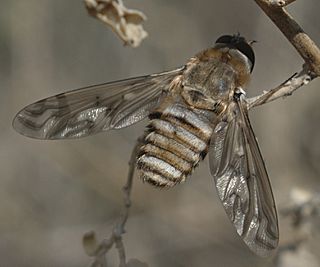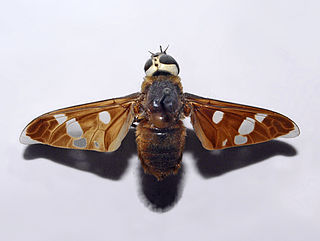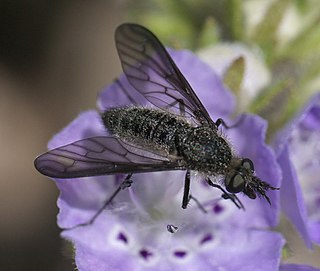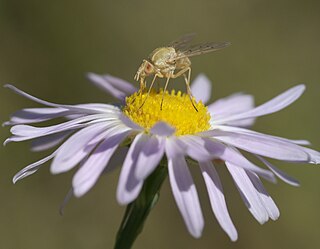
The Bombyliidae are a family of flies. Their common name is bee flies. Adults generally feed on nectar and pollen, some being important pollinators. Larvae generally are parasitoids of other insects.

Anthrax is a genus of bombyliid flies, commonly known as "bee-flies" due to their resemblance to bees. Most are dull black flies, and are usually small to medium in size, 4–20 millimetres (0.2–0.8 in), and many species have striking wing patterns.

Astraptes is the genus of flasher butterflies. They belong to the skipper butterfly subfamily Eudaminae, which was long included with the spread-winged skippers (Pyrginae) as a tribe. They are found in the Nearctic and Neotropical ecozones.

The Lauxaniidae are a family of acalyptrate flies. They generally are small flies with large compound eyes that often are brightly coloured in life, sometimes with characteristic horizontal stripes, such as in Cestrotus species. Many species have variegated patterns on their wings, but in contrast they generally do not have variegated bodies, except for genera such as Cestrotus, whose camouflage mimics lichens or the texture of granitic rocks.
Heterostylum is a genus of flies belonging to the family Bombyliidae (bee-flies). There are 14 described species, distributed throughout the Americas. These are robust and very hairy flies with a body length of 10–15 mm. They can be distinguished from similar genera by an indentation in the hind margin of the eye and unique wing venation.

Villa is a genus of flies belonging to the bee-fly family (Bombyliidae). They range in size from 5 to 17 millimetres, and have typically rounded heads. The males of some species have a brilliant mat of silvery patagial scales. About 270 Villa species are found on all continents except Antarctica. They can be distinguished from similar genera (Hemipenthes) by their wing venation.

Hemipenthes is a large genus of flies belonging to the family Bombyliidae (bee-flies). There are many described species, distributed throughout the Holarctic realm. These are small to large robust flies with a body length of 5–14 mm. They can be distinguished from similar genera (Villa) by their wing venation. A number of species formerly in this genus were moved to a separate genus, ins in 2020.

Toxophora is a genus of flies belonging to the family Bombyliidae (bee-flies). There are 47 described species, distributed throughout the world, although they are most abundant in Southwestern United States and western Mediterranean. World catalog of bee flies They are strange, stout, robust flies with a hunchbacked form, with a body length of 6–12 mm and wings 4 to 7.5mm. Most species are black with banding or spots.

Balaana is a genus of flies belonging to the family Bombyliidae (bee-flies). There are about seven described species, including three from western Australia. These are robust and very hairy flies with a body length of 10–18 mm (0.4–0.7 in).

Poecilanthrax is a large, primarily Nearctic genus of flies belonging to the family Bombyliidae (bee-flies).

Hyperalonia is a genus of bee flies in the family Bombyliidae.
Chespiritos is a genus of flies of mostly neotropical distribution, belonging to the family Sphaeroceridae.

Anthracinae is a subfamily of bee flies in the family Bombyliidae. There are more than 80 genera and 2,000 described species in Anthracinae.

Bombyliinae is a subfamily of bee flies in the family Bombyliidae. There are about 65 genera and more than 1000 described species in Bombyliinae.

Poecilognathus is a genus of bee flies. There are at least 20 described species in Poecilognathus.

Phthiriinae is a subfamily of bee flies in the family Bombyliidae. There are about 11 genera and more than 120 described species in Phthiriinae.

Chrysanthrax is a genus of bee flies in the family Bombyliidae.
Tmemophlebia is a genus of bee flies in the family Bombyliidae. There are about 16 described species in Tmemophlebia.

Sparnopolius is a genus of bee flies, insects in the family Bombyliidae. There are about 17 described species in Sparnopolius.
Anthrax analis is a species of bee fly in the family Bombyliidae.















